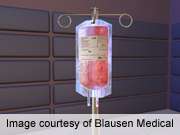Blood transfusions for spinal fusion holding steady

(HealthDay)—Among U.S. patients undergoing spinal fusion, the rates of allogeneic blood transfusion (ALBT) increased from 2000 to 2009, while predonated autologous blood transfusion (PR-ABT) rates decreased, according to a study published in the Feb. 15 issue of Spine.
Hiroyuki Yoshihara, M.D., Ph.D., and Daisuke Yoneoka, of the New York University Hospital for Joint Diseases in New York City, utilized data from the Nationwide Inpatient Sample (2000 to 2009) to identify patients who underwent spinal fusion. International Classification of Diseases, Ninth Revision, Clinical Modification codes were used to further identify patients who received PR-ABT, perioperative autologous blood transfusion (PE-ABT; intraoperative and postoperative blood collection), and ALBT.
The researchers observed an increasing trend over the study period in the ALBT rate (4.3 to 8.0 percent; P < 0.001), and a decreasing trend in the PR-ABT rate (2.6 to 0.7 percent; P < 0.001). The rates remained stable for overall blood transfusion and PE-ABT. For subgroups of patients, such as pediatric and elderly patients; female patients; patients with increased Elixhauser Comorbidity Score; Medicare patients; and patients who underwent thoracolumbar, posterior, and anterior and posterior fusion, the ALBT rate was high.
"The overall blood transfusion rate remained stable; however, it may be reduced by using a patient blood management program, targeting the subgroups of patients with the high ALBT rate," the authors write.
More information:
Abstract
Full Text (subscription or payment may be required)
Copyright © 2014 HealthDay. All rights reserved.


















